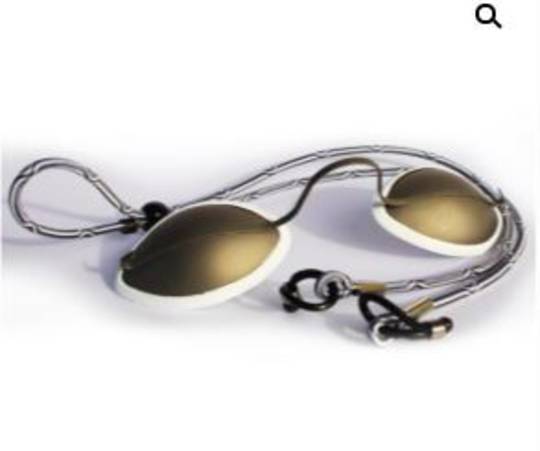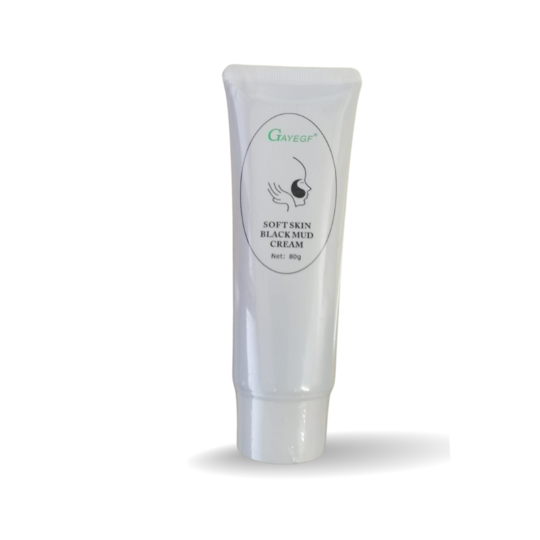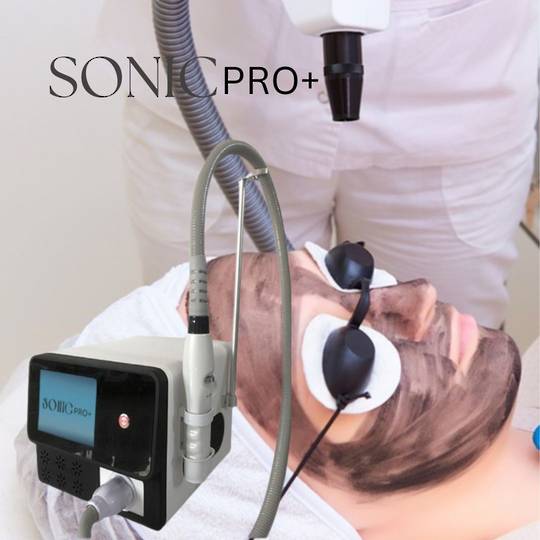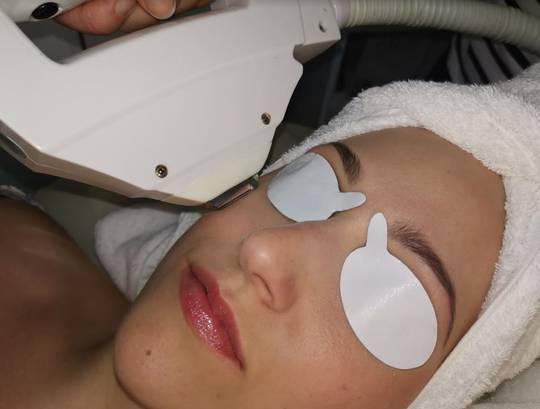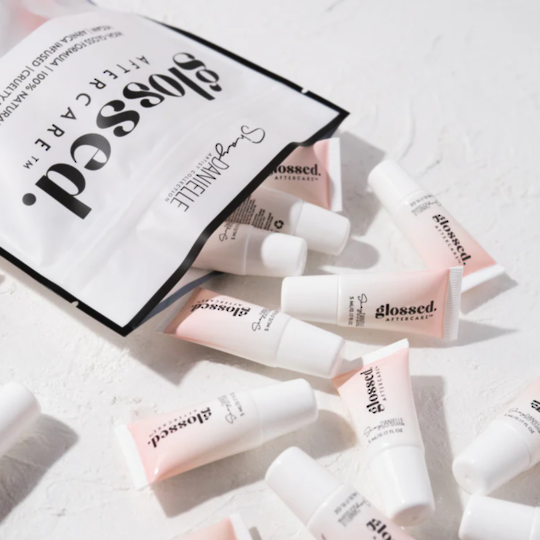Results After only 2 Sessions! Image Courtesy of Xtraction Beauty.
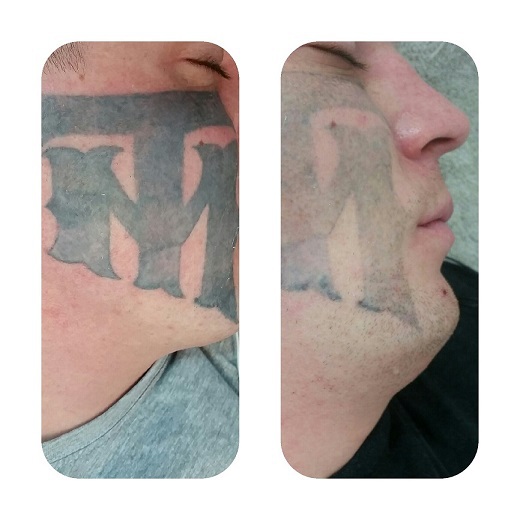
Applications
- 1064nm wavelength for treating dark blue and black pigment
- 532nm wavelength for treating red/brown pigment
Tips
- 2mm tip
- 4mm tip
- 532nm adaptor
| Laser Type: |
Q-Switched Nd: YAG Laser |
| Wavelength: |
1064nm / 532nm |
| Output: |
200mj; 400mj; 600mj / 800mj |
| Pulse Duration: |
<20ns |
| Pulse Rate: |
1-5Hz |
| Dimensions: |
430x330x250mm3 |
| Weight: |
12kg |
A Q-Switch Neodymium (Nd) laser utilizes a crystal doped with neodymium ions, emitting near-infrared light at 1060 nm, specifically for photocoagulation and photoablation. This wavelength effectively targets dark blue and black tattoos.
A KTP laser employs a potassium titanyl phosphate crystal to convert an Nd
laser beam into a green visible spectrum at 532 nm. This frequency-doubled wavelength is ideal for removing red tattoos through photoablation and photocoagulation.
Benefits/Differentiators Compared to Other Tattoo Removal Lasers:
- These lasers are supported in New Zealand with dedicated assistance from Youth Beauty, renowned for their quality and reliability.
- They offer flexibility with additional 2mm and 4mm spot size tips for both 1064nm and 532nm wavelengths. Other systems typically provide only one spot size option.
Q-Switch Technique:
- Provides quick treatment sessions with straightforward operation.
- Features a solid Q-switched laser with precise software control.
- Offers low discomfort without the need for anesthesia.
- Requires minimal downtime after treatment.
- Virtually eliminates the risk of tissue damage or scarring.
This comprehensive approach ensures efficient and safe tattoo removal, distinguishing these lasers in terms of effectiveness, versatility, and patient comfort.
How does it work?
Contrary to popular belief the laser does not remove tattoo ink. Instead high intensity flashes of light is absorbed by the tattoo pigment. This light energy is then converted into heat energy, which causes the sells with ink in them to shatter into microscopic pieces. These tiny pieces of debris is then picked up by a person's immune system and removed through the body’s natural elimination processes over a period of time. You will be able to see your tattoo fading away.
Will the laser remove all of the tattoo?
Laser tattoo removal is very effective at removing (dark) blue, black and red inks. Therefore in many cases the tattoo can be completely removed, if not completely it will be significantly lightened (approx. 97% gone). Purple and orange also respond well. Colours such as (grass) green, (sky) blue and yellow can be difficult to remove.
How long does it take?
Usually a series of treatments is required to achieve satisfactory results. It depends on the method used for getting the tattoo - as a guide, Amateur (ballpoint or Indian ink) tattoos requires approximately 3-6 separate treatments whereas professional tattoos (where a gun has been used) requires approximately 6-9 treatments. In order to gain the biggest benefit from treatments, we allow 6 weeks between sessions. Sessions range from 15 to 30 minutes
Are there any side effects?
After the laser tattoo removal procedure, the area may be red or swollen and is similar to mild sunburn. This is to be expected for five days to several weeks. Some pinpoint bleeding is associated with the treatment. Application of antibacterial ointment and a dressing is applied to the treated area of skin and normally heals within a few days.
Is there any risk of scarring?
Normally the risk is about 1% for chance of scarring. The biggest risk factor is broken skin, which can lead to infection which can then increase the risk of scarring. Therefore protecting the area after treatment considerably reduces chances of scarring. Some hypo-pigmentation (lightening of the skin) or hyper-pigmentation (darkening) may occur during the course of treatments but this usually fades away within 6 months of treatment completion.
Does it hurt?
The treatments can be painful. A local anaesthetic cream is applied 0.5hours - 1hour before each treatment to assist in reducing any discomfort. The good news is - your discomfort is dependent on the amount of ink. As it disappears, the discomfort becomes minimal.
How much will it cost?
Exact costing can be quoted during a personal consultation. In general for an area approximately the size of a business card it is approximately $160. Arm bands 1.5cm wide is around $150. For larger tattoos please phone for an estimate price.
What Happens After Laser Tattoo Removal?
The treated area should be kept clean with continued application of any ointment given to you by your therapist. Showers can be taken but you must keep the skin clean and dry for 5-7 days and the area that has undergone laser tattoo removal should not be scrubbed.
Will I be able to go back to work after treatment?
Yes, most people do. It all depends on where the tattoo is, and what your occupation is, eg if you have tattoos on your hands, and work with fluids, abrasives, toxic substances, or similar - you would need to protect the treated area from the risk of infection or injury.There are many factors which can affect the number of treatments necessary to effectively complete removal of a tattoo:
- Amateur or professional tattoo – Amateur tattoos are easier to remove as usually they are not as deep as professional tattoos and the ink is more sparsely applied. Amateur tattoos are usually only a single colour (black or blue), whereas many professional tattoos are multi coloured.
- Type of ink used – The pigment types are divided into plant pigment, mixture of different pigments and chemical pigments. The plant based pigment is the easiest to dispel, while the chemical pigment is the most difficult. If pigment contains contains iron and lead in the mixture and chemical pigment, it may not react well to laser treatments and can be difficult to remove.
- Depth of ink – Generally speaking the deeper the pigment, the more difficult to remove and it may take many times to dispel. The tattoo will easily dispel if the depth of the pigment is thin. Any treatment will not react well if the pigment is chemically based, even if the depth of the pigment is thin.
- Colours in tattoo – Black and blue tattoos are the easiest to remove while the green and yellow pigments are the hardest, there is not an ideal wavelength that either of these colours absorb. Tattoos that have had white (titanium oxide) applied cannot be removed until the white has faded. UV inks cannot be treated.
- Age of tattoo – Older tattoos are usually easier to treat, new tattoos contain more pigment and often multiple colours.
- Clients healing ability - Many different factors affect healing: physique of a person, age, skin, body immunity, colour of skin and so on. Generally speaking 3 – 4 weeks healing is required between treatments.
On average, professional tattoos require 5-10 treatments, while amateur tattoos may require 4 or more treatments due to the different composition of inks. Treatments are spaced approximately four to eight weeks apart. The number of treatments depends on the amount and type of ink used and the depth of the ink in the skin. Having realistic expectations of treatment results is important and complete removal of pigment can never be guaranteed. During the consultation, your treatment regimen will be reviewed and any questions you have will be answered.
What to be aware of:
Some DIY or overseas pigments within a tattoo can contain banned or hazardous materials, for example, iron-oxide materials. The problem with this is that these pigments can turn black when exposed to a laser beam. In other words, it can make the tattoo look worse. If you have had the tattoo overseas or from an unknown source please inform us and we can complete a patch test beforehand to see if the pigments in your tattoo contain any such materials. Laser tattoo removal does not work for everyone and we will discuss the various scenarios with you depending on the colour, type of ink and depth of ink. This then gives you the choice of deciding whether to go ahead or not with the treatment.
The New Zealand government has published Guidelines for tattoo and permanent makeup substances. See the government details here. 
